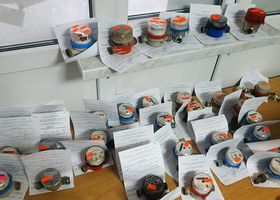Ukraine’s thorny way towards liberal electricity market

While Ukraine is about to recover from its New Year and Orthodox Christmas celebration, there is one more thing worth celebrating. On 1.1.2019, Ukraine took one big leap towards liberalizing its retail electricity market along European standards. As of this date, consumers are free to choose their electricity supplier. Well, almost all consumers. Household and SME segment will, by default, continue to be served by incumbent suppliers (that at the moment of receiving the license were part of vertically integrated companies) who have been tasked to perform the so called universal service obligation up to mid-2020. In theory, household and SME consumers can opt for a commercial supplier (other than universal service supplier) but since the maximum price the universal supplier can charge to consumers is set administratively on the basis of a tariff approved by the Ukrainian regulator, no en masse switching away from universal suppliers is expected. After all, this was the intention of the legislator. Government was keen to ensure that no household or small business is left without a supplier once the reform kicks in. The length of the period during which universal service suppliers will maintain a de facto monopoly is debatable, of course.
Competition at the retail market is, therefore, likely to happen mainly in the segment of larger consumers, at least in the first phase. Industrial consumers can negotiate a supply contract with whichever supplier they choose and switch supplier rather frequently (several times per year). Up to January 2019, as many as 179 suppliers have signed contract with Energorynok, the Ukrainian Market Operator who until July 2019 is the only entitled entity to purchase and sell electricity at the wholesale market. The fact that Energorynok will maintain this monopoly for the next six months and will until July continue to set wholesale market price administratively, seriously limits the competition at the retail market level. It is not clear on what basis the retail suppliers will compete if the electricity they buy at the wholesale market is the same for everybody and no competitive advantage can be gained. Because of this, the real competition even in the larger consumer segment is likely to take off only after July 2019 when the wholesale market fully opens up.
However, even after the wholesale market opening things might prove problematic. Implementation of processes that are key for proper functioning of the wholesale market (such as the balancing settlement process or central administration of metered data) is lagging behind. Lack of competition between the electricity producers is even more serious obstacle to a liquid and healthy wholesale market. There are few large generators present at the market (basically the state-owned conventional power plants and DTEK-owned power plants) and the possibilities of cross-border trade is limited. Only a relatively small part of Ukraine (the Burshtyn island) is linked to liquid EU markets. Interconnectors with Russia and Belarus are not used for trading purposes and possible market coupling with Moldova is likely to have relatively limited impact on the Ukrainian electricity market liquidity and disruption of the current oligopoly-like market structure. Quick physical integration with the ENTSO-E area and further liberalisation of export and import (currently subject to prior Governmental approval) of electricity have the potential to increase the liquidity of Ukrainian electricity market considerably.
With all these caveats mentioned, is there really anything to celebrate? Definitely yes. A lot has been done during 2018 to make the launch of the retail market a reality. In particular, NEURC, the Ukrainian energy market regulator has in record-short time drafted and adopted all necessary secondary legislation (which is all the more impressive since the first months of 2018 was marked by loss of quorum required to take decisions and the institution was paralysed). In March 2018, Market Rules, Retail Market Rules, Distribution System Code and Commercial Metering Code were adopted. As a result, architecture of contractual relations between market participants and other key processes such as switching rules, dispute resolution procedures or data metering were established. During early autumn 2018, NEURC adopted tariffs for DSOs, tariffs for universal service supplier and tariffs for supplier of last resort. Establishment of tariff methodology and predictable tariff structure for each of these market participants is a precondition for unbundling and termination of cross-subsidised system. Universal service suppliers must be able to function independently from the DSOs within the same holding structure; DSOs must receive enough funds to finance the maintenance and development of the grid. Towards the end of the year, NEURC approved contracts between Energorynok, universal service suppliers and suppliers of last resort, and in the last days of 2018 Government decided to establish the state-owned company Ukrinterenergo (responsible for electricity imports/exports) as supplier of last resort for the entire territory of Ukraine until January 2021.
These steps required considerable efforts and some aspects remain controversial and/or unsolved. For example, the date of transition towards incentive based regulation (using he regulated asset base as a basis for tariff calculation) for DSOs has been postponed. Compensation model for universal service providers to cushion the effects of possible wholesale market volatility post July 2019 is far from clear. The situation of protected customer and the issue of finding appropriate balance between payment discipline and protection from supply interruption (as evidenced by state owned water supply companies) remains unsolved. An efficient support system for vulnerable consumers with difficulties to cover utility bills will need to be introduced. At the same time, as already mentioned, Ukrenergo has made little progress in establishing the IT system for centralized balancing settlement administrator and so far, Government has not selected the authorized bank that will handle the trading collaterals and imbalance clearing. It is difficult to assess market participants’ readiness for the new market (although, based on surveys undertaken by the Project Office during 2018 some progress could be noted). Some market players (such as Energoatom) have taken concrete steps and have for example already procured IT systems that will enable them to purchase and sell the electricity through OTC and at DAM/IDM market. Others are still struggling with tailoring the appropriate strategy and may lag behind with IT system procurement and implementation of other organisational measures (setting up call centers, efficient billing systems, etc.). However, there are experienced companies that are already active in Ukraine and are able to offer ready-made solutions for market participants. Some foreign companies, including Slovak ones, are assisting Ukrenergo and other Ukrainian market participants.
Despite all these deficiencies and imminent challenges, there are reasons to applause Ukraine in their efforts to liberalize its energy markets. Except of Baltic states and Georgia, Ukraine is the only post-Soviet country to go along such path. Obviously, it will take some time for the retail and wholesale electricity market to stabilize but at the end of the road lays the reward in the form of more competitive and secure power market with the perspective of joining the EU-wide electricity market on equal terms to the benefit of the Ukrainian electricity consumer.
Kristian Takac
Head of the Electricity Retail Market Working Group at Project Office
(Coordination Centre for Electricity Market Implementation, Ukraine)








